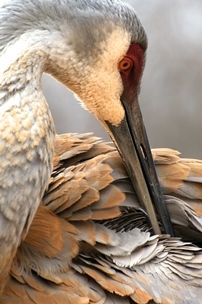The sandhill crane: October’s Migratory Bird Treaty Centennial featured bird
Oct. 28, 2016
 Once a rare sight in Michigan, sandhill cranes have made a remarkable comeback. These large, loud, prehistoric-looking birds can be found in fields, wetlands and even parks and neighborhoods near you. Once a rare sight in Michigan, sandhill cranes have made a remarkable comeback. These large, loud, prehistoric-looking birds can be found in fields, wetlands and even parks and neighborhoods near you.
Sandhill cranes stand about 4 feet tall, with long necks, long legs, gray-brown bodies, 6.5-foot wingspans and featherless red foreheads. The only bird species in North America taller than the sandhill crane is the whooping crane, a species which is critically endangered and is a very rare visitor to Michigan.
While commonly seen feeding on grains in agriculture fields, sandhill cranes also eat frogs, fish and insects along with both terrestrial and aquatic plant life, fruits and seeds.
Sandhills become mature at 3-4 years of age and dance to attract a mate. Crane dances are very intricate and showy! Both the male and female cranes dance, which is fairly unusual in the bird world. These cranes have strong pair bonds and may keep the same mate for years, but each spring they still dance with their existing mate to reinforce their pair bond. Again, this is unusual in the bird world – putting on a courtship display after being accepted by a mate – it’s a little like an old married couple going on a date.
Sandhill cranes nest in wetlands and build their mound-like nests out of wetland vegetation from around the nest site. Traditionally two eggs are laid. The young birds are able to walk and follow their parents around at the tender age of one day old. The young birds are able to fly by the time they are 70 days old but stay with the adults for about a year.
Unlike many birds, sandhill cranes don’t start breeding the year after they hatch – they’re not old enough yet. They do fly back north to Michigan on migration every year. These young birds hang out with other “teenage” cranes (too old to stay with their parents, not old enough to find a mate and breed) in flocks all summer, looking for food and places where they’ll be safe from predators. Like teenagers at the mall food court, they want an easy meal and will stay anywhere they feel safe.
One of the most awe-inspiring sights and sounds in Michigan can be observed this month. October is an excellent time of year to observe sandhill cranes gathering together in huge, raucous groups as they prepare for the fall migration southward.
Most birds either migrate alone or species synchronize their migration so that entire populations leave their breeding territories and move southward en masse. Cranes are different. They stage before migrating south. Individual cranes, small flocks and family groups start to gather in late September and early October on “staging areas” – wetlands where they roost together overnight as they prepare to migrate.
The flocks on these staging areas grow and grow through October and peak late in the month before they start to move to staging areas farther south in Indiana and beyond. The staging area on Michigan Audubon Society’s Baker Sanctuary near Bellevue can draw in 10,000 cranes some years, and their Haehnle Sanctuary near Jackson has seen years with well over 5,000 cranes!
This species saw a population decrease in the early part of the century due to human disturbances, which they do not tolerate well. Habitat loss also played a large part in the decline, as the wetlands they depend on for nesting were drained for agriculture. Still another factor leading to population decline was overhunting, primarily by market hunters who sold both the crane’s feathers and meat.
By 1944 only 27 pairs remained in the Lower Peninsula. Today, the sandhill crane population in Michigan is growing at a rate of about 10.5 percent a year. The estimated population in the spring of 2013 was about 24,000. In some areas, these cranes are so numerous that they are considered agricultural pests.
The sandhill crane is protected under the Migratory Bird Treaty Act. The year 2016 marks the centennial of the Convention between the United States and Great Britain (for Canada) for the Protection of Migratory Birds (also called the Migratory Bird Treaty), signed on Aug. 16, 1916. Three other treaties were signed shortly thereafter with Japan, Russia and Mexico. The Migratory Bird Treaty, the three other treaties signed later, and the Migratory Bird Treaty Act form the cornerstones of efforts to conserve birds that migrate across international borders.
The 2016 Migratory Bird Treaty Centennial celebration has included monthly featured bird stories to our DNR Wildlife Viewing email subscribers, celebration events including a weekend of bird-based programming at state parks and visitor centers in June of 2016, an education program for schools and conservation groups, and more.
To learn more about the Migratory Bird Treaty Centennial, visit www.fws.gov/birds/MBTreaty100. To sign up for DNR Wildlife Viewing emails, visit www.michigan.gov/dnr and click on the red envelope.
/Editors’ note: Contact – Holly Vaughn, 313-396-6863. An accompanying photo is available below for download. Suggested caption:
Standing around 4 feet tall with a wingspan of nearly 7 feet, sandhill cranes are an impressive sight to see./
The Michigan Department of Natural Resources is committed to the conservation, protection, management, use and enjoyment of the state’s natural and cultural resources for current and future generations. For more information, go to www.michigan.gov/dnr.
|

 Once a rare sight in Michigan, sandhill cranes have made a remarkable comeback. These large, loud, prehistoric-looking birds can be found in fields, wetlands and even parks and neighborhoods near you.
Once a rare sight in Michigan, sandhill cranes have made a remarkable comeback. These large, loud, prehistoric-looking birds can be found in fields, wetlands and even parks and neighborhoods near you. 




